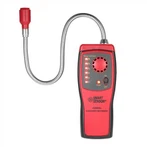The method of using a clamp ammeter to detect leakage and theft of electricity
A clamp ammeter is a powerful tool for checking for leakage or theft in low-voltage circuits.
Determine if there is a problem with the residual current action protector itself
At the distribution transformer, disconnect the fuse on the phase line of the AC contactor controlling the low-voltage line. If the residual current operated protector can be put into operation normally at this time, it proves that the residual current operated protector is good. Otherwise, the residual current operated protector should be repaired and replaced.
Check and determine which phase line has leakage
At the distribution transformer, disconnect the neutral wire on the output side of the AC contactor controlling the low-voltage line, and then install the removed fuse core on one of the phases. Measure the phase with a clamp ammeter, and the measured current is the leakage current of that phase. To prevent the presence of phase grounding on the circuit (such as someone stealing electricity by using a one line, one place method) and causing high current damage to the instrument, first place the clamp ammeter in the high current position during testing; If the detection value is very small, then switch the clamp ammeter gear to milliampere gear for detection.
After determining the phase line with leakage, determine the location of the leakage
At the distribution transformer, insert a fuse core into the phase line to be checked, disconnect the neutral line from the fuses of the other two phases, and use a clamp ammeter to detect the live phase line on the pole to determine the leakage position. In the case of low-voltage power transmission, clamp ammeters can also be used to detect low-voltage user connection lines within the suspected range. When testing, the phase and neutral wires of single-phase users should be placed in the clamp of the clamp ammeter at the same time, and the three phase and neutral wires of three-phase users should also be placed in the clamp at the same time. If there is no leakage fault, the clamp ammeter indicates zero, otherwise it is not zero.
Check if there is any leakage in the user's internal wiring and equipment
Measure the leakage current of the user's power supply at the incoming line using a clamp ammeter. At the same time, put the user's electrical equipment and lamps into and out one by one, and detect the changes in leakage current by looking at the clamp ammeter to find the leaking equipment. If all devices are in good condition or devices with leakage have been removed, but the clamp ammeter shows that the user still has leakage current, it is possible that the user's low-voltage line has leakage, and it should be handled according to the specific situation.






